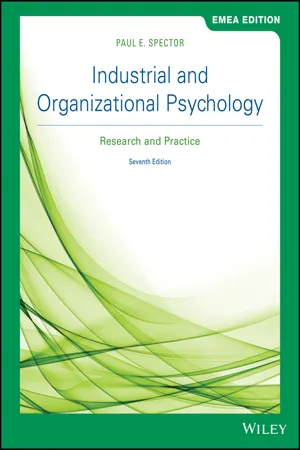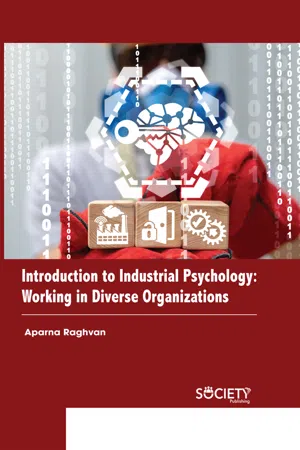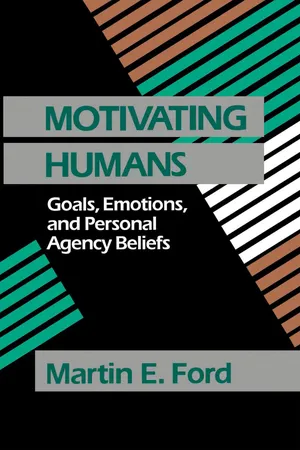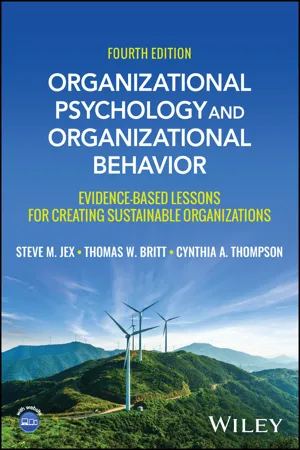Business
Integrating Theories of Motivation
Integrating theories of motivation involves combining different psychological perspectives to understand and enhance employee motivation. This approach draws on theories such as Maslow's hierarchy of needs, Herzberg's two-factor theory, and expectancy theory to create a comprehensive understanding of what drives individuals in the workplace. By integrating these theories, businesses can develop more effective strategies for motivating their employees.
Written by Perlego with AI-assistance
Related key terms
1 of 5
10 Key excerpts on "Integrating Theories of Motivation"
- eBook - PDF
Industrial and Organizational Psychology
Research and Practice
- Paul E. Spector(Author)
- 2021(Publication Date)
- Wiley(Publisher)
(In Chapter 10, we will explore other things that affect performance, as well as other forms of work behavior, such as turnover.) This chapter begins by defining motivation in the context of the work environment. It then intro- duces work motivation theories and provides a brief overview of the nine theories to be covered. Each theory is next discussed in greater detail, along with the research evidence for its validity. OUTLINE What Is Motivation? Work Motivation Theories Need Theories Need Hierarchy Theory Self-Determination Theory Expectancy Theory Self-Efficacy Theory Justice Theories Equity Theory Fairness Theory Goal-Setting Theory Control Theory Action Theory Chapter Summary I-O Psychology in Practice Learning by Doing References Work Motivation Theories 179 What Is Motivation? Motivation is defined as an internal state that induces a person to engage in particular behaviors. From one perspective, it has to do with the direction, intensity, and persistence of behavior over time. • Direction refers to the choice of specific behaviors from a large number of possible behaviors. For example, an employee might decide to volunteer for an extra work project that will require him or her to work overtime instead of going home on time and relaxing. • Intensity refers to the amount of effort a person expends at doing a task. If an employee is asked to sweep a floor, the person can exert a lot of effort by sweeping hard and fast or exert a little effort by sweeping softly and slowly. • Persistence refers to the continuing engagement in a behavior over time. An employee might try to accomplish something over an extended period of time, such as studying to pass the CPA exam to become a certi- fied public accountant, even though it might take several attempts. From another perspective, motivation is concerned with the desire to acquire or achieve some goal. That is, motivation derives from a person’s desires or wants. - eBook - PDF
Industrial and Organizational Psychology
Research and Practice
- Paul E. Spector(Author)
- 2020(Publication Date)
- Wiley(Publisher)
This chapter discusses job performance in terms of several popular theories, with a focus on motivation rather than ability. (In Chapter 10, we will explore other things that affect performance, as well as other forms of work behavior, such as turnover.) This chapter begins by defining motivation in the context of the work environment. It then introduces work motivation theories and provides a brief overview of the nine theories to be covered. Each theory is next discussed in greater detail, along with the research evidence for its validity. Theories of Employee Motivation Work Motivation Theories 185 What Is Motivation? Motivation is defined as an internal state that induces a per- son to engage in particular behaviors. From one perspective, it has to do with the direction, intensity, and persistence of behavior over time. Direction refers to the choice of specific behaviors from a large number of possible behaviors. For example, an employee might decide to volunteer for an extra work project that will require him or her to work overtime instead of going home on time and watching television. Intensity refers to the amount of effort a person expends at doing a task. If an employee is asked to sweep a floor, the person can exert a lot of effort by sweeping hard and fast or exert a little effort by sweeping softly and slowly. Persistence refers to the continuing engagement in a behavior over time. An employee might try to accomplish something over an extended period of time, such as studying to pass the CPA exam to become a certified public accountant, even though it might take several attempts. From another perspective, motivation is concerned with the desire to acquire or achieve some goal. That is, motivation derives from a person’s desires or wants. Some people, for example, are highly motivated to acquire money. It is presumed that a high level of motivation to have money affects the behavior relevant to acquiring it. - Aparna Raghvan(Author)
- 2020(Publication Date)
- Society Publishing(Publisher)
Worker Motivation 8 CONTENTS 8.1. Introduction .................................................................................... 130 8.2. Need Theories of Motivation ........................................................... 130 8.3. Positive Employee Attitudes and Behaviors ...................................... 145 8.4. Employee Engagement .................................................................... 146 8.5. Job Satisfaction ............................................................................... 147 8.6. Employee Attitudes and Employee Attendance ................................ 150 8.7. Increasing Employee Engagement, Job Satisfaction, and Organizational Engagement .................................................. 153 Chapter Introduction to Industrial Psychology: Working in Diverse Organizations 130 8.1. INTRODUCTION The fact that people apply motivational approaches to inspire performance in individuals necessitates a proper understanding of this process. It is both crucial and essential to understand the factors that have an impact on motivation. Motivation theories are aligned in two dissimilar directions, where one focuses on content and the other on motivation processes. Both approaches are dissimilar. The focus of the content theory is individual needs while the focus of process theories is the psychological aspect of the motivation process. Motivation and performance are characterized by a strong process. Issues [AP4] such as employee productivity, motivation, and job performance were not considered as factors of job satisfaction and hence many scholars did not bother investigating into policed matters (Herzberg, Mausner, and Snyderman, 2011). 8.2. NEED THEORIES OF MOTIVATION 8.2.1. Basic Need Theories Employee satisfaction can be significantly enhanced by close relations among co-workers. The close relationship is perceived as a promoter of a sense of belonging in a work setting since it is a level of professional cooperation.- eBook - PDF
Managing People in Today's Law Firm
The Human Resources Approach to Surviving Change
- Bruce H. Charnov, Jonathan Lindsey, Ellyn Weisbord(Authors)
- 1995(Publication Date)
- Praeger(Publisher)
The Theoretical Underpinnings Many theories exist to explain the psychology of human motivation. These theories fall into two categories: content theories and process theories. Content theories specify what motivates people. These theories focus on the needs that individuals seek to satisfy and the rewards they seek to gain. For the most part, content theories provide a variety of ways to look at the question of whether people are motivated by the need for intrinsic rewards—rewards that are inherent to the job itself, like feelings of accomplishment, pride in one’s work, and the fun of the work itself; or extrinsic rewards—rewards which come from the larger work context, like money, vacations, and convivial co- workers. Process theories attempt to explain how people are motivated: that is, the process by which motivation occurs. Even assuming that we know what people want in the way of rewards, motivation doesn’t always result from the offer of rewards or the threat of punishment. Process theories look at the psychological processes that explain why this is so. These theories are important. Each has something to give you. Pick the one that works for you within the context of your own firm. Maybe it will be an amalgam of all of them. Content Theories We will first look at several of the best-known content theories of motiva- tion. These include Abraham Maslow’s Hierarchy of Needs Theory, Clayton Alderfer’s ERG Theory, Frederick Herzberg’s Two-Factor Theory, and J. Rich- ard Hackman and Greg Oldham’s Job Enrichment Theory. Each of these the- ories presumes that people have needs, and that the attempt to reduce tension by satisfying these needs is the cause of behavioral activity. The first theory, that of Abraham H. Maslow, is probably the most widely known motivational theory. Maslow was concerned with motivation in general, not within the work context, but his work is important as it forms the basis for all ‘‘need’’ theories. - eBook - PDF
- Michael A. Hitt, C. Chet Miller, Adrienne Colella, Maria Triana(Authors)
- 2017(Publication Date)
- Wiley(Publisher)
Thus, environmental factors can also play a role in performance. This brings us to our definition of work motivation. We know from the preceding discussion that ability and certain environmental factors exert influences on performance that are separate from the effects of motivation. Motivation, then, refers to forces coming from within a person that account for the willful direction, intensity, and persistence of the person’s efforts toward achieving specific goals, where achievement is not due solely to ability or environmental factors. 3 Several prominent theories offer explanations of motiva- tion. Most of the theories can be separated into two groups: those concerned largely with content and those concerned largely with process. In the next two sections, we consider theories in each of these two groups. Content Theories of Motivation Content theories of motivation generally focus on identifying the specific factors that moti- vate people. These theories are, for the most part, straightforward. Three important content theories of motivation are Maslow’s needs hierarchy, McClelland’s need theory, and Herz- berg’s two-factor theory. Hierarchy of Needs Theory One of the most popular motivation theories, frequently referred to as the hierarchy of needs theory, was proposed in the 1940s by Abraham Maslow. 4 According to Maslow, peo- ple are motivated by their desire to satisfy specific needs. Maslow arranged these needs in hierarchical order, with physiological needs at the bottom, followed by safety needs, social and belongingness needs, esteem needs, and, at the top, self-actualization needs. Maslow’s hierarchy of needs is presented in Exhibit 6‑1. In general, lower-level needs must be sub- stantially met before higher-level needs become important. Below, we look at each level and its theoretical implications in organizational settings. 1. Physiological needs Physiological needs include basic survival needs—for water, food, air, and shelter. - eBook - ePub
Motivating Humans
Goals, Emotions, and Personal Agency Beliefs
- Martin E. Ford(Author)
- 1992(Publication Date)
- SAGE Publications, Inc(Publisher)
CHAPTER SIX
Integration of Historical and Contemporary Theories of Motivation
It helps, I think, to consider ourselves on a very long journey: the main thing is to keep to the faith, to endure, to help each other when we stumble or tire, to weep and press on. Mary Caroline RichardsPurpose of This ChapterAS NOTED IN CHAPTER 1, the present book was designed to provide scholars, professionals, instructors, and students with an alternative to the traditional “survey-of-theories” method of portraying the nature of human motivation. Specifically, an explicit effort was made in the preceding chapters to focus on the substance and significance of motivational processes and patterns and to avoid highlighting artificially constructed rivalries among “competing” theorists. Thus the strategy taken thus far has been to link theorists’ names and concepts to a core set of ideas rather than to present each theory as if it represented a separate set of ideas. This addresses the concern expressed so eloquently by Staats (1991) in his call for integrative theorizing:Scientists, at first, only have a goal of finding new and different phenomena, not of finding relationships between them. Only over long periods and with continuing efforts are the different pieces of knowledge gradually joined into a unified structure . . . .There are many common concepts and principles and findings in which commonality is not recognized because they are described in different languages and are parts of different theories. The theories may be in competition or the separation may be accidental through the use of different subjects and different methodologies and apparatuses, or through development in different problem areas. The widespread, unrecognized commonality magnifies psychology’s diversity immeasurably, making the knowledge in the discipline vastly more complicated and unrelated than it need be . . . .The ability to see commonality, in principle, through thickets of superficial difference is at the heart of creating unified science. (pp. 899-900, 905) - eBook - PDF
Organizational Psychology and Organizational Behavior
Evidence-based Lessons for Creating Sustainable Organizations
- Steve M. Jex, Thomas W. Britt, Cynthia A. Thompson, Cynthia A Thompson(Authors)
- 2024(Publication Date)
- Wiley(Publisher)
Clearly, researchers are only beginning to examine how social forces within an organization can shape employee motivation and performance. CHAPTER SUMMARY The first major section of this chapter reviewed what are considered to be the major theories of motivation in organiza- tional research and how organizations have used ideas from these models to enhance motivation. The major theories covered included expectancy theory, goal-setting theory, behavioral theories, SDT, and JCT. The Expectancy and Goal Setting theories are both cognitively oriented, addressing how employees think about the connection between behaviors and outcomes. The Behavioral Approach to employee motiva- tion involves using principles adapted from behaviorism to influence behavior in organ- izations. The principle used most frequently is reinforcement, although others, such as punishment, shaping, and extinction, may be used in certain situations. SDT empha- sizes the importance of not only the quan- tity, or amount, of motivation, but the quality of that motivation. Proponents of this theory state that employees driven by autonomous motivation at work will be more satisfied and perform better than employees who experience their behavior as controlled by others. This theory has received a great deal of support outside of the organizational context and generated a great deal of research in recent years. The second major section of the chapter examined how organizations have applied these theories to influence employee motiva- tion. Without a doubt, the most widely used mechanism that organizations use for moti- vating behavior is reward systems. Tangible rewards include merit pay, incentive pay, bonuses, and fringe benefits. Research over the years has shown that tangible rewards such as pay can be very powerful motivators of employee behavior. - Michael L. Vasu, Debra W. Stewart, G. David Garson, Michael L. Vasu, Debra W. Stewart, G. David Garson(Authors)
- 2017(Publication Date)
- Routledge(Publisher)
hygiene factors and are related more to a need to avoid unpleasantness. Included among these factors are supervision, working conditions, salary, interpersonal relationships, relationships with subordinates, and company policy. Hygiene factors tend to be extrinsic to the individual. The implication of this theory is that managers who insist on stressing extrinsic or hygiene awards will fail to harness the full energy of their employees, for these rewards will only make the work situation more tolerable. The trash collection analog is often used, we expect certain minimal hygiene standards such as the trash to be collected, if the trash is not collected, a major hygiene factor that can lead to dissatisfaction exists. Eliminating that dissatisfier, by collecting the trash, returns us to a state where things are as we expect them. From a work perspective, company policy, administration, quality of supervision, working relations with fellow employees, and salary, are hygiene factors that can lead to employee dissatisfaction. However, what makes an employee want to work are motivators. To motivate an employee the work, itself, must be made valuable. Valuable work is work that provides an opportunity for responsibility, recognition, achievement, and presents opportunities for growth and advancement. In other words, intrinsic rewards can engage the higher level needs of the human spirit.Figure 5 A graphical representation of Herzberg’s conceptual framework.The two factor theory of motivation leads to a focus on job enrichment as the entry point for motivating employees. Recall, we said previously that Malsow’s needs hierarchy provided the conceptual framework for attempts to move away from the specialization of job tasks that were derived from scientific management. Herzberg’s research provided the empirical platform for many job enrichment efforts designed to enhance the nature of work. Many such efforts were tried and not all proved successful. Herzburg attributes such failures to the fact that managers confuse horizontal job loading with vertical job loading. Horizontal job loadings imply enlarging already meaningless work. Only vertical job loading, a form of job enrichment which directly taps motivators, will produce motivated action. The principles of such job enrichment include removing some control while retaining accountability, increasing the accountability of an individual for her own work and giving that person a complete natural unit of work (module, division, area, and so on), and granting additional authority to the employee. It also requires making periodic reports directly available to the worker herself rather than to the supervisor. Finally, job enrichment includes introducing new and more difficult tasks not previously handled and assigning individuals specific or specialized tasks, enabling them to become experts.Herzberg and his associates report extensive research on this two-factor theory. Studies conducted on over 1600 employees, including lower level supervisors, agricultural administrators, foremen, military officers, engineers, scientists, and accountants, lent support to the Herzberg model. Also, Schwartz et al., (1963) claimed support for the two-factor theory in their study of public utility workers, and Dysinger (1966) found support in his study of scientists and engineers. Cross national research conducted in Israel using educators lends support to Herzberg’s two factor theory (Gaziel, 1986). However, Herzberg’s work has its critics (Lawler, 1973). The major disagreements center on disputes about whether job attitudes, in fact, constitute a single dimension or a continuum. Others contend that Herzberg’s findings are tied to his methodology, i.e., when respondents are interviewed they relate critical incidents about “satisfying” and “dissatisfying” events. However, when independent rating scales are employed these findings are more difficult to replicate (Silver, 1987). In general, studies employing different ways of measuring factors leading to satisfaction support the notion that any factor can produce effects ranging from satisfaction to dissatisfaction (Graen and Hulin, 1968). Regardless of these criticisms, Herzberg’s theory has been widely popularized and has taken on tangible expression in various proposals for job enrichment.- eBook - PDF
Supervisory Management
The Art of Inspiring, Empowering, and Developing
- Donald Mosley, Donald Mosley, Jr., Paul Pietri, , Donald Mosley, Donald Mosley, Jr., Paul Pietri(Authors)
- 2018(Publication Date)
- Cengage Learning EMEA(Publisher)
Kurt Lewin, famous 2. Explain the relation- ship between perfor- mance and motivation. EXHIBIT 7-3 Factors Affecting an Individual’s Job Performance Job Performance Personal Motivation Personal Abilities, Skills Level of Organizational Support Copyright 2019 Cengage Learning. All Rights Reserved. May not be copied, scanned, or duplicated, in whole or in part. Due to electronic rights, some third party content may be suppressed from the eBook and/or eChapter(s). Editorial review has deemed that any suppressed content does not materially affect the overall learning experience. Cengage Learning reserves the right to remove additional content at any time if subsequent rights restrictions require it. Chapter 7: Motivation 197 for his work in the study of groups, once said there is nothing so practical as good the- ory. The remainder of this chapter focuses on the important theories of motivation, with emphasis on their application to effective supervision. Maslow’s Hierarchy of Needs Theory One theory particularly significant and practical was developed by psychologist Abraham H. Maslow and is known as the hierarchy of needs. Of all motivation theories, it is prob- ably the one best known by managers. The key conclusion drawn from Maslow’s theory is that people try to satisfy different needs through work. 8 Principles Underlying the Theory The two principles underlying Maslow’s hierarchy of needs theory are (1) people’s needs can be arranged in a hierarchy, or ranking of importance, and (2) once a need has been satisfied, it no longer serves as a primary motivator of behavior. To understand the signifi- cance of these principles to Maslow’s theory, let us examine the hierarchy of needs shown in Exhibit 7-4. Physiological or Biological Needs At the lowest level, but of primary importance when they are not met, are our physiological or biological needs. “Man does not live by bread alone,” says the Bible, but anything else is less important when there is no bread. - eBook - PDF
Skills of Management and Leadership
Managing People in Organisations
- W. David Rees, Christine Porter(Authors)
- 2017(Publication Date)
- Red Globe Press(Publisher)
Expectancy theories Another perspective that needs to be integrated with the previously explained theories is that provided by the expectancy school of motivational theorists. The expectancy approach attempts to overcome one of the criticisms of other motivational theories by accounting for individual differences. The general thrust of this approach is to examine whether or not whether incentives are in line with employee expectations. It follows that it is necessary to check whether the reward system in an organization actually works in the way that it is intended to work. It is no good, for example, expecting to motivate people by offering incremental sal-ary increases or promotion on the basis of merit if the reality is that such rewards are based on seniority or some other factor not connected with merit. Employees are likely to make judgements about what reward system really operates by what they believe is actually happening, rather than by statements of organizational policy. Even if rewards are based significantly on merit it is necessary to convince people of that, as motivation is likely to depend on what people perceive to be happening. It is also necessary to review how equitably rewards are distributed. Even if people are inclined to respond to a particular incentive, they may be discouraged from doing so by per-ceived unfairness in the way in which rewards are distributed. The relation-ships between the rewards given to different people may therefore need to be examined, as well as the size of the rewards. The gap between intended and actual reward systems can be alarmingly high. As is explained in the next chapter, some reward systems can degenerate into arrangements for restrict-ing rather than increasing performance. Impact of national culture When considering theories of motivation and seeking to improve employee motivation via reward structures or redesigned jobs, the poten-tial impact of national culture needs to be taken into account.
Index pages curate the most relevant extracts from our library of academic textbooks. They’ve been created using an in-house natural language model (NLM), each adding context and meaning to key research topics.









